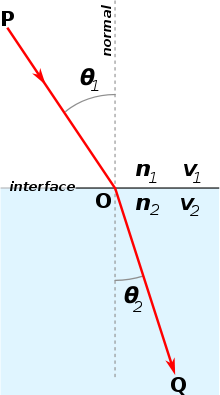
Snell's law (also known as the Snell–Descartes law and the law of refraction) is a formula used to describe the relationship between the angles of incidence and refraction, when referring to light or other waves passing through a boundary between two different isotropic media, such as water and glass.
In optics, the law is used in ray tracing to compute the angles of incidence or refraction, and in experimental optics and gemology to find therefractive index of a material. The law is also satisfied in metamaterials, which allow light to be bent "backward" at a negative angle of refraction (negative refractive index).
Although named after Dutch astronomer Willebrord Snellius (1580–1626), the law was first accurately described by the Arab scientist Ibn Sahlat Baghdad court, when in 984 he used the law to derive lens shapes that focus light with no geometric aberrations in the manuscript On Burning Mirrors and Lenses (984).[1][2]
Snell's law states that the ratio of the sines of the angles of incidence and refraction is equivalent to the ratio of phase velocities in the two media, or equivalent to the opposite ratio of the indices of refraction:
with each  as the angle measured from the normal,
as the angle measured from the normal,  as the velocity of light in the respective medium (SI units are meters per second, or m/s) and
as the velocity of light in the respective medium (SI units are meters per second, or m/s) and  as the refractive index (which is unitless) of the respective medium.
as the refractive index (which is unitless) of the respective medium.
 as the angle measured from the normal,
as the angle measured from the normal,  as the velocity of light in the respective medium (SI units are meters per second, or m/s) and
as the velocity of light in the respective medium (SI units are meters per second, or m/s) and  as the refractive index (which is unitless) of the respective medium.
as the refractive index (which is unitless) of the respective medium.
The law follows from Fermat's principle of least time, which in turn follows from the propagation of light as waves.
in Wikipedia
Learn more about the mathematics of refraction in physicsclassrom.
Watch this video about refraction in gases (MIT):



No comments:
Post a Comment